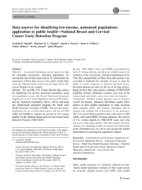
An official website of the United States government
Here’s how you know
Official websites use .gov
A .gov website belongs to an official government organization in the United States.
Secure .gov websites use HTTPS
A lock (
) or https:// means you’ve safely connected to the .gov website. Share sensitive information only on official, secure websites.
-
//
- Census.gov /
- Census Working Papers /
- Data Sources for Identifying Low-Income, Uninsured Populations
Data Sources for Identifying Low-Income, Uninsured Populations
Data Sources for Identifying Low-Income, Uninsured Populations
Abstract
Objective - To provide information on the sources of data for estimating low-income, uninsured populations. To recommend uses of these data sources. To demonstrate the application of these data sources in the public health field, using the National Breast and Cervical Cancer Early Detection Program as an example.
Methods - We describe U.S. Census Bureau data sources for identifying low-income, uninsured populations using two population surveys: the Annual Social and Economic Supplement to the Current Population Survey (CPS ASEC) and the American Community Survey (ACS), and using one model-based estimation program, the Small Area Health Insurance Estimates (SAHIE). We provide recommendations for use of these data sources, and we use CPS ASEC and SAHIE to estimate the percent of U.S. women eligible for the National Breast and Cervical Cancer Early Detection Program (NBCCEDP).
Results - CPS ASEC, ACS, and SAHIE are produced by the U.S. Census Bureau, and they are reliable sources for estimates of the low-income, uninsured populations in the USA. Key characteristics of these three data sources were presented to highlight the strengths of each to meet the needs of various programs at national and local levels. Recommendations are made on the use of the data sources. Based on these three data sources, estimates of NBCCEDP eligibility showed substantial variation over time at the national and state levels, and across states and counties.
Conclusions - Publicly funded programs that are directed toward low-income, uninsured individuals require information on their eligible populations to make decisions about program policy and resource allocation, and to monitor and evaluate the effectiveness of the programs. The U.S. Census Bureau produces three data sources (CPS ASEC, ACS, and SAHIE) for these estimates. The percent of U.S. women eligible for NBCCEDP varies over time and across states and counties. The data sources for these estimates are changing in order to measure key dimensions of the Affordable Care Act (ACA) and can provide helpful information for assessing the legislation’s impact.
Share
Related Information
Some content on this site is available in several different electronic formats. Some of the files may require a plug-in or additional software to view.
 Yes
Yes
 No
NoComments or suggestions?


Top

